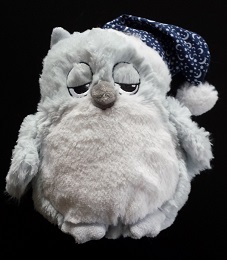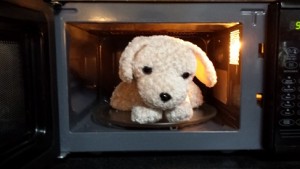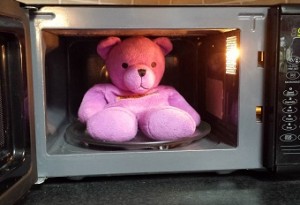What’s his name?

His name is Twitt
“Think of a name” I asked. With a great stretch of imagination he was christened Twitt! Fantastic, the latest addition to our family of microwaveable warmers. We were just putting away the last of the Christmas presents and Twit was being taken out of his packaging when I heard “what’s the instructions?” Why on earth would you need instructions? Taking the path of least resistance I read out the instructions. And would you believe it, instantly I had another topic for my blog.….
So what was it in the instructions that got me interested? It had something to do with moisture of course. Here’s the instructions, have a read and you’ll see in the first sentence the magic word that inspired this article….

Notice that you are not asked to place the bag in water to re-hydrate it. That is the key in appreciating how these microwaveable warmers work. Moisture gets into the grain inside the bag through the air and not by direct contact with liquid water. To get enough moisture quickly into the grain you are instructed to place the bag in a very high humidity environment which is generated by boiling a cup of water placed along with the bag in a microwave oven. But why should that work? How is it that you just don’t end up with a steamy bag of grain that dries off, and you’re pretty quickly back to where you started with dry grain? In order for these microwaveable warmers to work as a product, the grain has to retain moisture in normal room conditions also called “ambient conditions”. Grain naturally does this because it sits in equilibrium with moisture in the air as long as the relative humidity (%RH) is above a certain point. A full explanation of how this works is complicated but the basics are in chapter 3 of my eBook which can be downloaded for free.
Meet Zap our first microwaveable warmer
Now that I’ve dealt with the technical bit, time I think to introduce you to “Zap”. This microwavable warmer also has a grain bag for which I found a good use. Zap became important for me in a new direction in my life. I had put myself forward to give a talk at a conference in Vienna in November 2007. Lacking public speaking experience, and to try and gain some, I contacted local schools offering to give a talk called “What is Science?” A teacher at St. Augustine’s in Dungarvan kindly invited me in to present my talk to transition year students. During my talk I did a demonstration that required a source of heat to explain the link between temperature and relative humidity. “Meet Zap” I said to the students which caught their attention (three of the girls in unison said “ahh, isn’t he lovely”). Then I said “We call him Zap because…” whilst opening the door of a microwave “….we zap him in a microwave” to shrieks of horror (“Oh no”) from the girls.

Meet Zap who cannot be microwaved directly
Well actually we don’t, we take this bag of grain out of Zap and use that……
Coming back to grain and its equilibrium with moisture. If you had to keep on re-hydrating the grain with steam or even had to apply this treatment before use, it simply would not fly as a product. Most people would simply just not be bothered. To work as a product you need to have the microwaveable warmer as simple to use as possible. That is, open up the packaging and into the microwave it goes. By having a particular equilibrium point it means that, under most ambient conditions, the grain will contain some moisture even when it’s within its packaging and is ready for immediate use. Some microwaveable warmers do not have a grain bag but have the grain loose inside the body of the warmer.
Beddy Bear – a different sort of beast
Meet Beddy Bear, that’s his commercial name, who can be microwaved directly. It’s quite amusing to watch him going round and round, although I do think he looks a bit fed up.

Meet Beddy Bear who can be microwaved directly
The downside to this type of warmer is that heating something drives off moisture, and the whole thing can become quite damp if the grain has picked up a lot of moisture. Of course, the higher the humidity the more moisture will be taken up by the grain and the damper Beddy Bear and his friends become in the microwave. Quite logical really!

Zap & friends
If you would like to hear more about moisture and relative humidity in everyday life, please sign up for email alerts of my blogs.
Welcome to my world of moisture

Leave a Reply